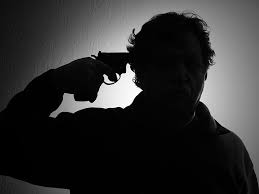
From the perspective of Theosophical teachings Suicide is not ever an escape because the person does not really Die. He wakes up in a realm in which he has little control and no longer has a physical body to use to escape the condition he is in. In Theosophical terminology it is the Kama-Loka, or desire-realm, which in natural death a short time may be spent in, and which there are natural processes going on for the separation of the higher and lower parts of our constitution. Our higher parts and essence of worthwhile experiece from the finished lifetime go for a long rest – “Devachan”, before once again entering a new lifetime. The lower parts of our constituion – the Astral or pattern body and latent mentality or personality gradually dissipate, to be partly picked up again in the next lifetime. The Eastern teaching of the Kama-Loka may have echoes in the Catholic idea of Purgatory. The Tibetan idea of the “Bardo” may be the same or similar idea.
While in a natural death from old-age the time spent in the Kama-loka is short, for the suicide the period has to extend at least until the natural lifetime of the life-that-was would have ended. If one committed suicide at 30, the period would extend 40 to 60 years or until the natural lifetime of 70-90 years or so would have been. Much of this time might consist of going over and over in one’s mind the last moments of life and the fatal act. We are “wound up” for so many years on earth, and must serve this time out somehow. We’re not just a physical body, but also an Astral or Pattern Body, and a Vital self in our lower nature. When the physical body is destroyed by the suicide, the Astral self is left intact, as it is unaffected and has a life-span the same as would have been the physical body’s. In the normal natural death, the astral body is a “corpse” also on that level with only at best a remaining automatic-like consciousness. This is the “ghost” that is sometimes seen, not a “spirit” at all, but a dissipating shell, and why the “spirits” of spiritualistic seances seldom make a bit of sense.
A worse result can occur to the suicide than being trapped in a Kama-lokic state for many years. As the suicide is not completely dead, he is may be aware still of the physical world, and without a body may be tempted to live by proxy the body and thoughts of the still living he senses around him, and can plague those mediumistic or sickly sensitive to such things. By doing this, the kama-lokic suicide ruins another life or lives and creates a whole new series of cause and effect, or karma, to affect his next lifetime, perhaps even attracting the “spook he was” as a fiend to plague his next attempt at life.
The variety of suicides and accident victims that have their life artificially cut short are endless, and nature has a just and appropriate place and result for each. The sacrificing hero in war is not a suicide. Death from overwork is not suicide. The suicide in a fit of insanity is not responsible and not a suicide. The accident victim from no intention of his own does not suffer in the after-death state.
References:
– “Suicide is Not Death,” W. Q. Judge
– “Is Suicide a Crime?,” H. P. Blavatsky, “The Theosophist,” Vol. IV, No. 38, November, 1882, pp. 31-32.
– “One Suicide’s Decision,” Victor Endersy, “Theosophical Notes,” Feb., 1952
– (Question on Suicide), Irene Ponsonby, W.E.S., “Eclectic Theosophist,” March 15, 1973
– “Thoughts by the Wayside – On Suicide,” [Maj. Hubert S. Turner], “Theosophia,” May-June, 1945
– “The Mahatma Letters to A.P. Sinnett,” (T.U.P. edition), p. 109, pp. 112-13, p. 132, p. 171.
———————
Hey Mark! 😉 I really liked this post, it was wonderful and enlightening. I’m a new blogger that writes about psychology too. Hope to see more of your stuff! 😉
LikeLiked by 1 person
Very good summary of the theosophical position, practical.
LikeLike